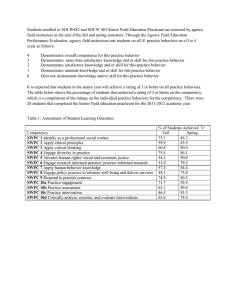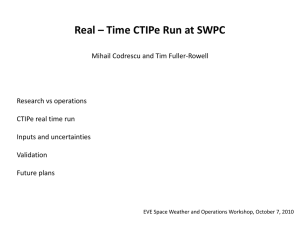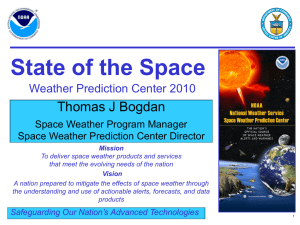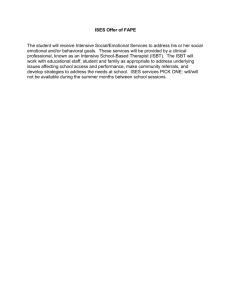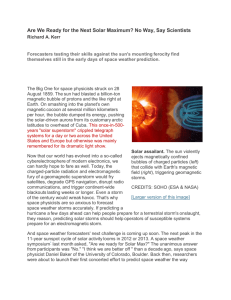INTERNATIONAL AIRWAYS VOLCANO WATCH OPERATIONS
advertisement
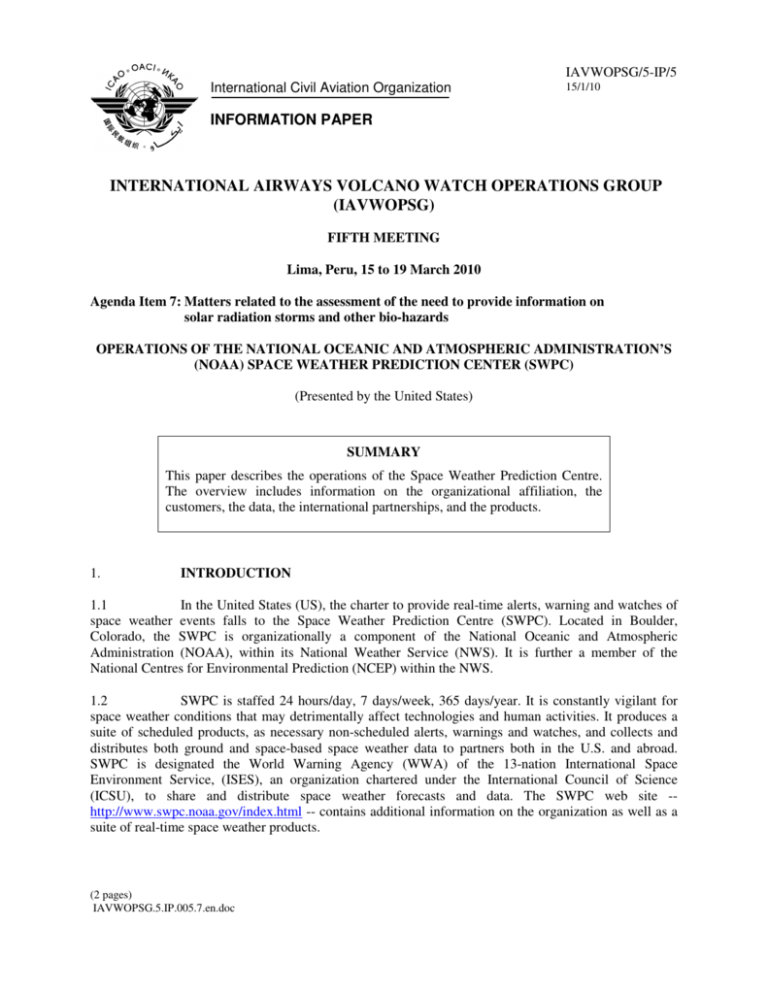
International Civil Aviation Organization IAVWOPSG/5-IP/5 15/1/10 INFORMATION PAPER INTERNATIONAL AIRWAYS VOLCANO WATCH OPERATIONS GROUP (IAVWOPSG) FIFTH MEETING Lima, Peru, 15 to 19 March 2010 Agenda Item 7: Matters related to the assessment of the need to provide information on solar radiation storms and other bio-hazards OPERATIONS OF THE NATIONAL OCEANIC AND ATMOSPHERIC ADMINISTRATION’S (NOAA) SPACE WEATHER PREDICTION CENTER (SWPC) (Presented by the United States) SUMMARY This paper describes the operations of the Space Weather Prediction Centre. The overview includes information on the organizational affiliation, the customers, the data, the international partnerships, and the products. 1. INTRODUCTION 1.1 In the United States (US), the charter to provide real-time alerts, warning and watches of space weather events falls to the Space Weather Prediction Centre (SWPC). Located in Boulder, Colorado, the SWPC is organizationally a component of the National Oceanic and Atmospheric Administration (NOAA), within its National Weather Service (NWS). It is further a member of the National Centres for Environmental Prediction (NCEP) within the NWS. 1.2 SWPC is staffed 24 hours/day, 7 days/week, 365 days/year. It is constantly vigilant for space weather conditions that may detrimentally affect technologies and human activities. It produces a suite of scheduled products, as necessary non-scheduled alerts, warnings and watches, and collects and distributes both ground and space-based space weather data to partners both in the U.S. and abroad. SWPC is designated the World Warning Agency (WWA) of the 13-nation International Space Environment Service, (ISES), an organization chartered under the International Council of Science (ICSU), to share and distribute space weather forecasts and data. The SWPC web site -http://www.swpc.noaa.gov/index.html -- contains additional information on the organization as well as a suite of real-time space weather products. (2 pages) IAVWOPSG.5.IP.005.7.en.doc -2- IAVWOPSG/5-IP/5 1.2.1.1 The history of the SWPC dates back to the mid-1960’s. Not only was there a keen interest in space physics then, due to the recent discovery of the solar wind and the radiation belts, but also the NASA manned space missions to the moon required a monitoring and predictive capability for the potentially lethal Solar Radiation Storms. The necessity for real-time, continuous space weather services was born in this era. 2. DISCUSSION 2.1 The SWPC monitors and predicts space weather. It is becoming increasingly clear that SWPC’s products will be a key to the safe management of the US’s National Airspace System (NAS) of the future. Already the space weather information is being used by the airlines that fly polar routes in the Northern Hemisphere, and to a lesser degree, in the Southern Hemisphere. 2.1.1 Space weather primarily affects three crucial areas for aviation; communications, navigation, and radiation exposure. Various modes of radio communication, both ground and satellite based, are affected by space weather. Electronic navigation systems such as GPS are planned to be used more extensively in the future for airspace traffic management; GPS is affected by space weather. Radiation levels, particularly at high latitudes and at high altitudes, vary as a function of space weather activity. Increased radiation affects not only the humans onboard the airplane, but also the computers that control vital in-flight functions. 2.1.2 Real-time data, primarily from satellite-based sensors, provide the basis for the summaries and forecasts from the SWPC. In addition to the data, there is a growing capability to employ physics-based models to extend the value of the information gathered from the satellites. Better spatial and temporal resolution should enable sharper forecasts of space weather for the aviation community. 2.2 Not only does the SWPC serve the U.S., it also serves the international community. As the ISES World Warning Agency, it receives the individual forecasts of the Regional Warning Centres (RWCs) daily, and issues the consensus World Forecast daily at 0330 UTC. The consensus forecast is the result of the ensemble constructed from the forecasts made by the international partners. More information on ISES is available at http://www.ises-spaceweather.org . 3. CONCLUSION 3.1 The SWPC is charged to be the official source of real-time alerts, warnings, and watches of space weather conditions in the United States. Aviation is increasingly needing space weather products and services, to mitigate detrimental impacts to communication and navigation systems, as well as ensuring safe levels of radiation exposure for the airplane and the passengers. The SWPC is wellconnected internationally through ISES, to facilitate the brokering of space weather products and services worldwide. 4. ACTION BY THE MEETING 4.1 The meeting is invited to note the information in this paper. — END —
